Is hikeabike just for masochists with no friends to go and ride with? Or is there real pleasure to be found in carrying your bike?
Words by Hannah, Photography as credited
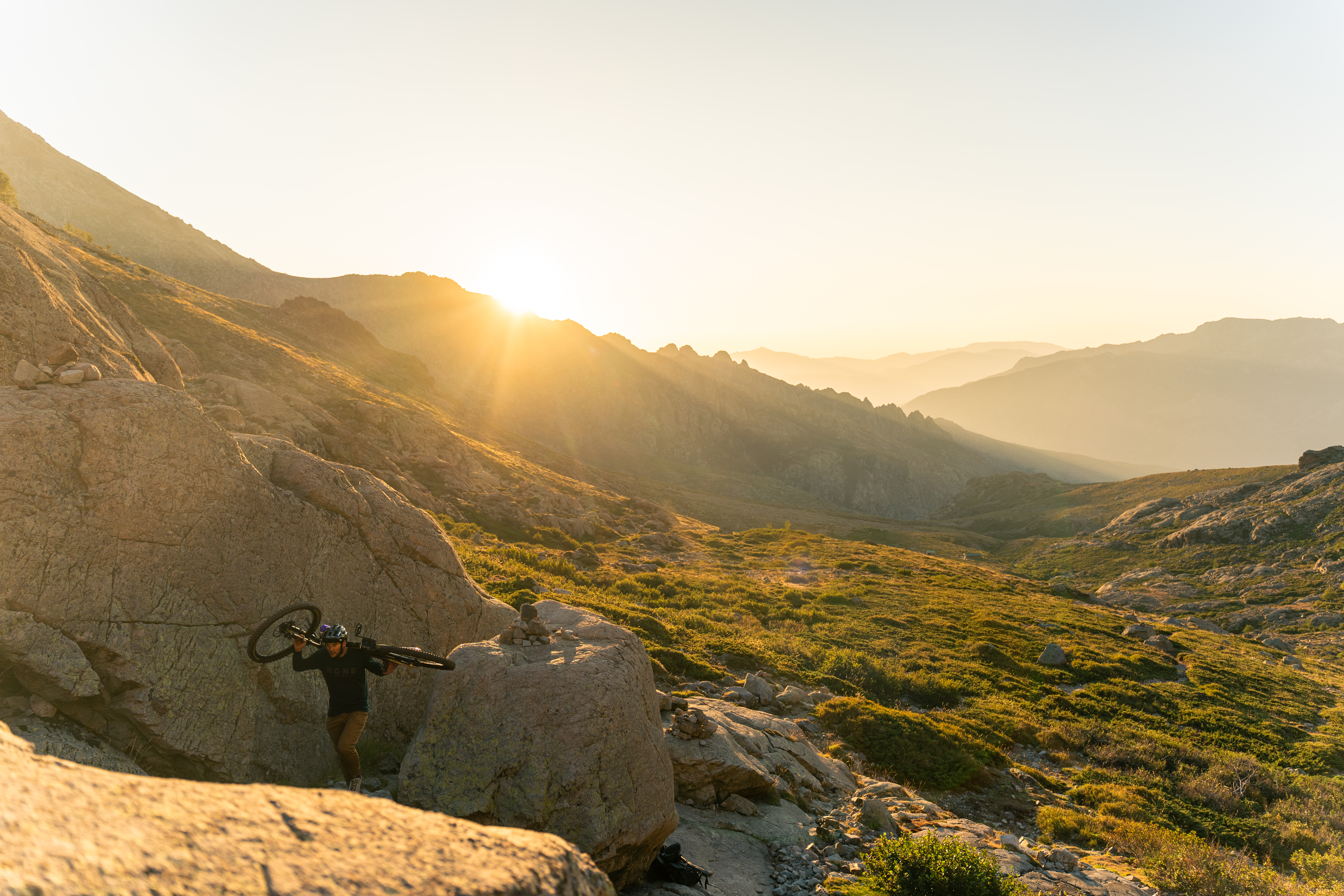
I cannot hikeabike.
Just hiking is pushing the limit of my wonky hip, and carrying the weight of a bike up a mountain would be a recipe for pain and misery, followed by weeks of more pain and misery. But my inability to join in the ‘fun’ does not, I think, make me the only person to look at those who willingly carry their bikes up mountains as slightly strange people who must enjoy a fair amount of… well… pain and misery.
I can understand a short section of lugging your bike up or over an unrideable section when it’s bookended by rideable stuff. I can see how pushing to the top of something big in order to be rewarded with a huge descent might just about pay off. But surely there comes a point where a bike is just the wrong tool for the job? Like golf, you’re just ruining a good walk? With no expectations of ever being able to join them, I wondered if some fans of hikeabike might be able to persuade me that I’m missing out. I caught up with some of its proponents to try to understand their motivation.
Latest Singletrack Merch
Buying and wearing our sustainable merch is another great way to support Singletrack
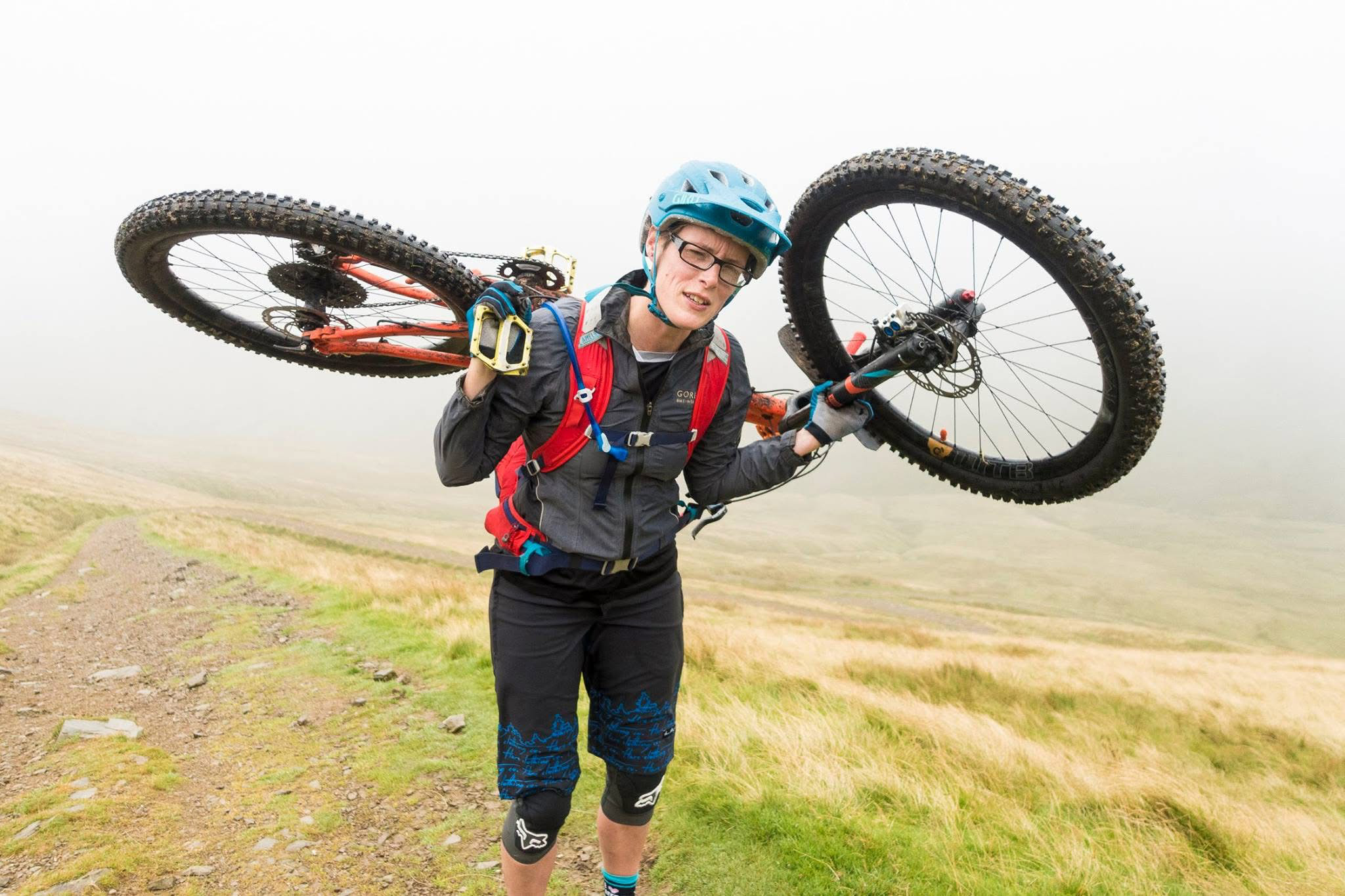
James Vincent discovered hikeabike when he moved to the Lake District. “When I started biking on Dartmoor, I didn’t do hikeabike because you didn’t need to. But then, riding in the Lake District, you’re like ‘If I want to get to the descents that are really, really good, I need to carry my bike to the top of them because they’re too steep to pedal up, or it’s too narrow, what have you’. And so it’s a means to an end to get to the trails that I like riding.”
‘A means to an end’ is exactly what Emily Greaves calls it too. “It’s a means to an end, I would say. I don’t like the idea of just doing hikeabike for the sake of it… where I live, in Scotland, there are some phenomenal descents that are just what you want to do.” She goes on to describe, almost misty-eyed with delight, the Ben Macdui descent in the Cairngorms. “Once you’re at the top, you descend and descend and descend… through just the most [wistful sigh]… like some of it’s pretty chunky and quite a gnarly descent, but it’s more than an hour all the way back down… down to Bob Scott’s Bothy and then out again.”
What we’ve slightly glossed over there is that Ben Macdui is one of the highest mountains in Scotland, and the most logistically simple way of doing the ride is to make a loop from Linn of Dee. “You can cycle in, which is pretty beautiful, but then you have got – and it is brutal – there’s an 800-metre hikeabike. And it’s not a push, it’s get-your-bike-on-your-back and carry it up a steep walkers’ path.” I can see that the alternative logistics of shuttling cars, or long road transfers – or an even longer push up and ride back down the way you came – might make just over an hour of bike hauling seem like a sensible option.
Ruth Finney echoed this. “Rather than taking five hours to go round the long circuitous way to get to the top of something, you can shoulder the bike and just straight line it up the side of a hill… especially if you’re pushed for time and you just want to get up and then get back down again.”
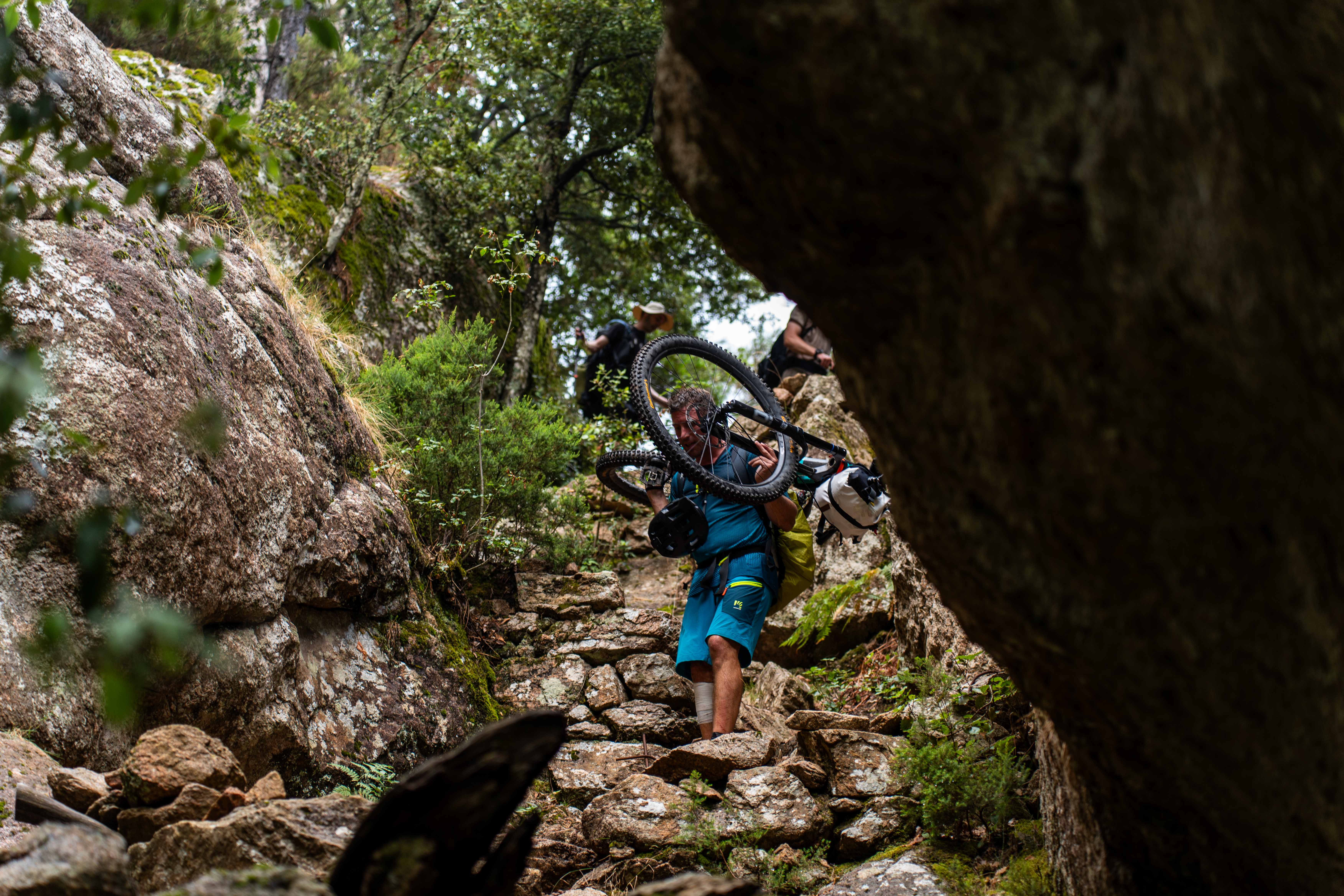
Going loopy
It’s not all about the descents or efficiency, though. Ruth thinks there’s a mental game benefit too. “It gives me a lot of confidence if I’m out riding something that I’ve never ridden before… If I know that I can at any point on the route just get my bike on my shoulders and tackle it that way, it gives me the confidence that I’ll just take on that route and not worry about the contour lines and what’s coming up.” She reiterates: “It’s so empowering… it’s like you feel invincible because you’ve got the bike and you’ve got the body to do whatever with the bike. It’s so empowering.”
Matthew Fairbrother likes the mental game too. “I think a big thing is challenging yourself. I think, for me, it’s a big part of it. Kind of scheming up an idea, making a plan, committing to it… it’s the whole picture instead of just the actual act of hiking a bike up a hill. It’s more the journey of it, I think, which is what it adds for me. So it’s more the mental side of it, the mental stimulation, the mental success – whatever you want to call it – which is what it adds to me.”
Both Ruth and Matthew tell me they like the process of looking at a map, figuring out a loop that looks like it will join up, and then heading to see what’s out there. Ruth says: “I think there’s the type of person who likes to go and drag their bike to the top of the mountain just so they can ride back down the mountain again. And then there’s the other type who are more the adventurous sort, who want to make a big loop of something and in order to make that loop complete there’s a section of hikeabike, and it’s all just part of the adventure. It’s not necessarily about getting to the top of the mountain to do some amazing gnarly descent back down, it’s more about being in the outdoors and having an adventure riding your bike. If it so happens that you’ve got to traverse a bit of terrain to make the full loop back to base, then that’s a necessary part of it. I definitely fall into the second camp… I’m not the sort of person who would go for it just because I thought there’s going to be an amazing descent; it would be more about the fact that if I did this it would just be an amazing circuit.”
Nine times out of ten a hikeabike is a slog

Risk and reward
The risk, of course, is that what you spy on the map turns out to be more walk than ride. Again, there are mixed opinions on how important it is to avoid this situation. Everyone seems to be aiming to ride more than they walk, and Emily is pretty clear that she doesn’t just head off into the unknown – she likes to know that there’s going to be a return on her efforts. Matthew and James, however, are happier to gamble. Over to James.
“I don’t have to know that it’s going to work out. It’s nice when it does. There was Matthew’s ride that he did in Corsica. We were talking about it and he was saying that some of the guys who were out filming it, they bailed off the first day because it was too much for them. And I was like, ‘So what’s the ratio of riding to hiking’? And I think Matthew said it was something like 90% hiking to 10% riding. That’s probably a bit too far. But, the adventure side of it, and exploring, and going somewhere new that you haven’t taken a bike is amazing. And not knowing quite whether it’s going to work or not is really fun. I like that aspect of it. But then to have some kind of pay-off – it makes it even more worthwhile. Like when we did Beinn Eighe together [with Matthew], I knew that some of the descents were going to be amazing and hadn’t heard many stories of people taking bikes across. There were some bits that were horrible and I’d never want to go back there again. But when you’re wrapping it up as part of a big adventure day with a bunch of like-minded people, then the hike becomes part of the whole experience.”
Matthew seems to have a lower bar to bike carrying – he’s prepared to risk there being a fair amount of suffering. He describes his attempt at ‘riding’ the GR20 in Corsica. “I was never going there to have a good time. I think a lot of it was wanting to push myself and see what I was capable of. Because I willingly knew that a lot of it wouldn’t be bikeable. But it was how far could I get? And, what could I learn? What could that teach me? And, what would I walk away with? And, yeah, ultimately, I obviously failed and got halfway. But I think I’ve walked away with so much more skill, confidence in myself and just all the mental learns as well. So I think there’s a lot to learn out of that aspect because nine times out of ten a hikeabike is a slog. But that built some big mental foundations and toughness.”
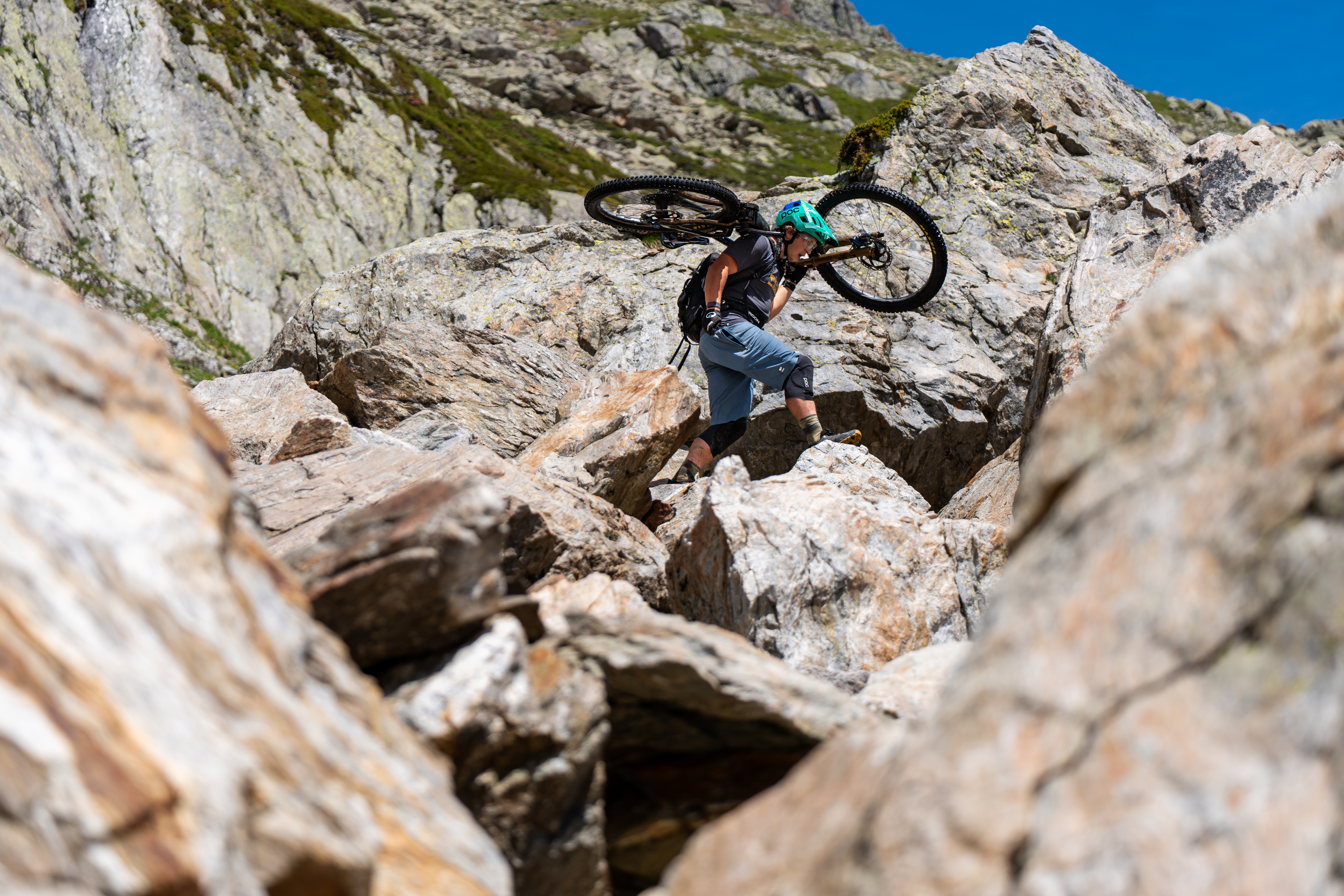
Fellowship in pain
I’m glad Matthew’s not in sales, but at least he’s upfront about the likely suffering. As James noted, Matthew’s film crew decided the GR20 was a step too far and bailed after the first day. But both agree that hikeabike can be a very sociable occasion – something which comes as a significant surprise to me. James explains: “A lot of the hikeabikes I do, they’re with friends. You get more chance to catch up, I think, on the carry-up. And then you have this shared – not euphoria exactly – but you’ll wait for everyone at the top, and everyone gathers and you have a bit of a chat before then dropping in. I don’t know if you get that quite so much elsewhere. I’m thinking of like, if you go to the Golfie or somewhere and you’re just pedalling up a fire road. I mean, pedalling up fire roads is dull. It’s really dull. I’d much rather carry my bike up a mountain top singletrack. It’s way more interesting.”
Matthew agrees: “That’s a good point. I think it does slow the pace down heaps. And it’s a lot more sociable because the pace is so slow. There’s no emphasis on pace most of the time, which also means you’ll be stopping on the descents a lot more than you usually would. So you’re catching up a lot with people and always talking and laughing. I think there’s something about having a shit time together, which is also quite good.”
Ruth thinks it’s wise to choose your bike-carrying buddies carefully. “I’ve got different riding friends for different types of bike riding… When it’s been big routes and big days out I’ve done a lot of that solo anyway.” Emily has deliberately tried to cultivate more bike-carrying friends. “There is a lovely group of people who were just up for doing some mad stuff! I’ve worked hard to get more women [to do hikeabike] because there were a lot of men here that ride that I’m friends with who are up for stuff like that, but there weren’t quite so many women. But I’ve managed to get a few of them around to my way of thinking!.”
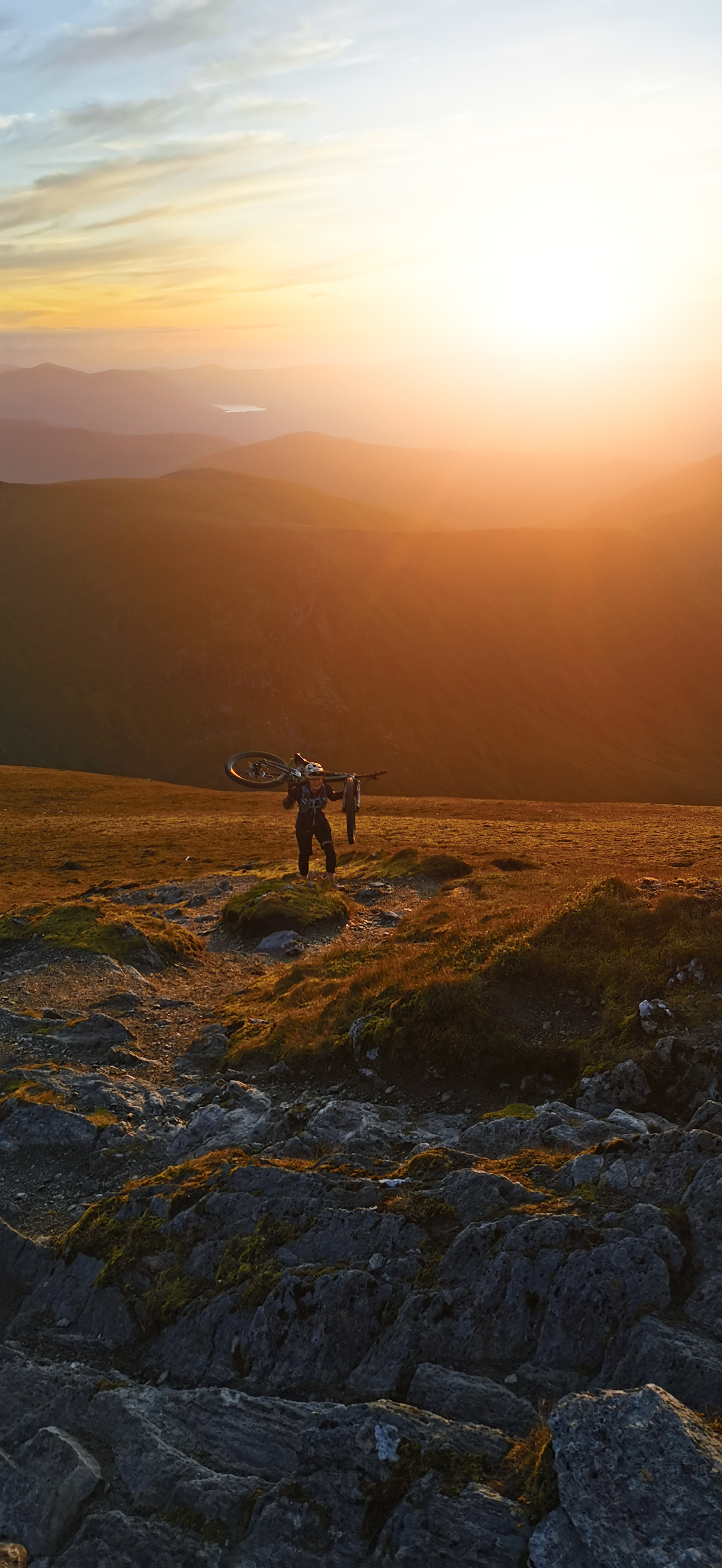
A balancing act
No one I speak to describes carrying your bike as a particularly nice experience, but everyone thinks it’s something worth doing that can add to a ride. I suspect they’re all just a bit tougher than me. As an ex-Captain in the Royal Engineers, I think I could have guessed Emily was tougher than me even before she talked so enthusiastically about hikeabike. She said: “I quite like hard work. And I quite like the fact stuff is hard work, because then the reward feels better. For me, you’ve earned that descent, and it feels better. But rather than think ‘Oh my god, this is horrendous. I hate this’ – it’s always going to be horrendous. But you just make peace with the fact… ‘Yeah, it’s going to be hard, but it will end, and it will be worth it’.”
As well as adopting the right mindset, figuring out the carrying technique that suits you can make a lot of difference. Emily says she’d never carry a bike without a rucksack, or a specific bike-carrying harness, because otherwise it’s too painful. As a guide, she’s found the Restrap harness can be useful, as it gives her two free hands to help others push their bike if needed. James says: “I’ve got one guy in the Lakes. He has the bike upside down! So the top tube is resting on his right shoulder, wheels up in the air. And it looks the most awkward thing ever. But that’s what works for him, so that’s how he carries his bike.” James and Matthew prefer a more standard approach: “Holding on to the fork and the crank and then sending it straight up over your head and then onto your back.” I doubt very much I could manage that – I’d be sure to rip a nostril open with a pedal pin or something. Ruth offers up a technique which sounds altogether more achievable. “You get your bike higher than you on the slope, across the slope and level so it’s not going to roll away… and then you’ve got less far to lift because if you’re downhill of the bike it just kind of falls onto you quite easily. You’ve got less far to lift when you stand up. So that’s my technique, and I grab hold of the fork and the crank and then that stops things whacking you in the face.”
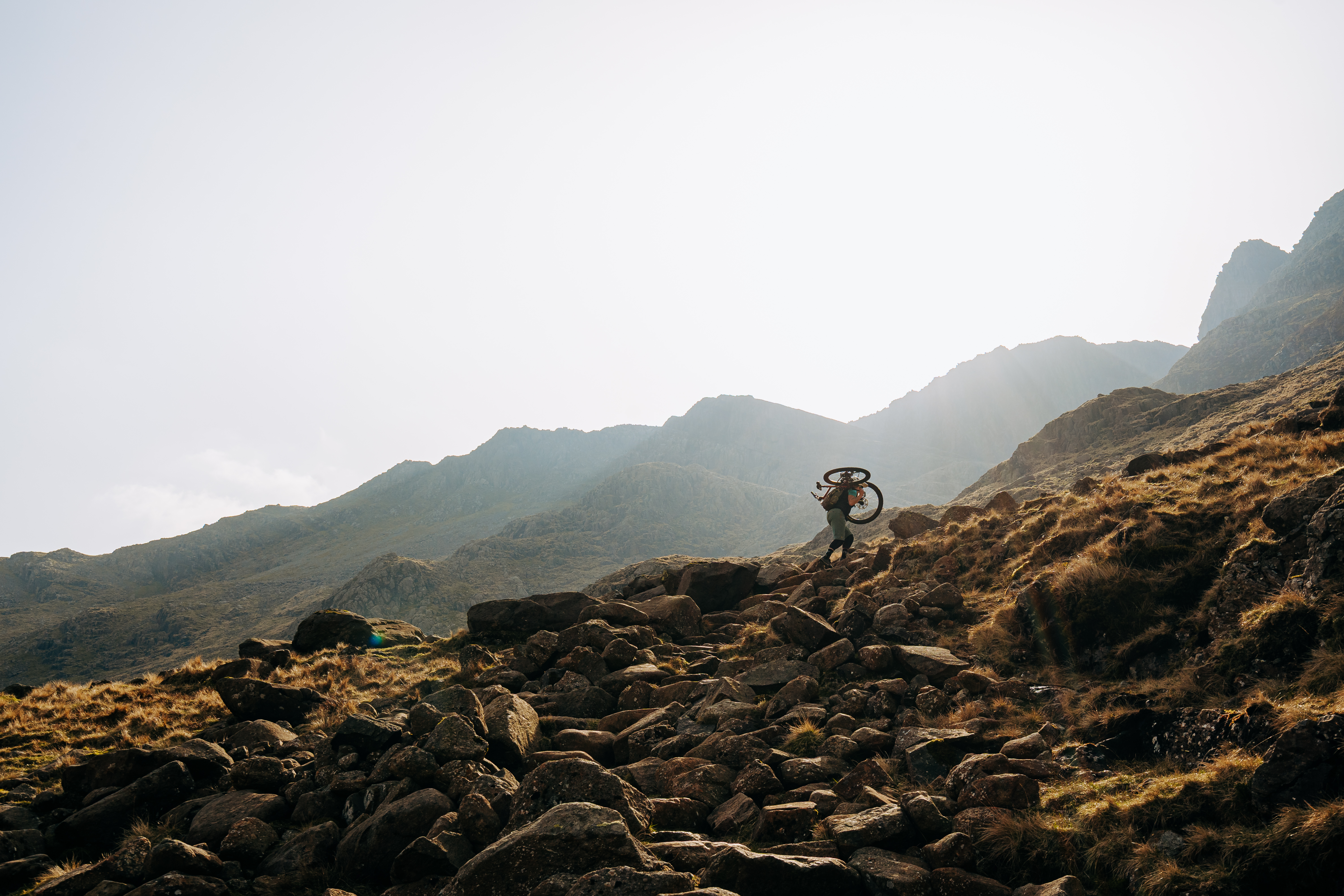
Are you feeling tempted?
Talking to these folks, I can sort of see that I might be missing out on something. It’s perfectly possible to ride mountain bikes without carrying them, but for some locations and terrain, a willingness to carry will open up more options. With a broader menu comes a wider variety of experiences. Some are like a hot curry – both a little painful, but also tasty at the same time. Some are more like a tequila slammer – a few hits of unpleasantness that make the finale taste sweeter. But like curry and alcohol, it’s probably not wise to go straight into a vindaloo and hard liquor shot. Matthew suggests a gentler entry, with plenty of rewarding descents as an incentive. “Starting out you’ve got to set yourself up for success. Otherwise, you’re not going to like the idea of hikeabiking. I think as you develop and do more hikeabiking, you’ll start to push it then and you’ll have the fifty-fifty ‘Can you bike down this or not?’. But I think definitely when I started hikeabiking, it was for a descent. And then it developed into the ‘What can you go and explore?’.”
James agrees that it’s something of a learned love. “I never grew up thinking ‘Yeah, I really want to carry my bike!’ It’s always about the end goal. The carrying just is part of it. I think I’ve grown to associate carrying my bike with fun adventures and great descents.”
I can certainly recognise the inner glow you feel in the sort of situation Emily describes here: “In the evenings if we’ve done something like that [hikeabike], you’re standing on the top of the hill and you can see the lights of the villages and you’re like, ‘Oh they’re all inside and we’re the clever ones, we’re out here!’.”
Perhaps the extra work of hikeabike might make the reward all the sweeter, but being outside is always pretty great. However we get our hits, whether it’s via a moorland meander, a fire road slog, or a brutal bike-carrying march, I think we can all experience the slight smugness of just being ‘out there’. How will you get yours?
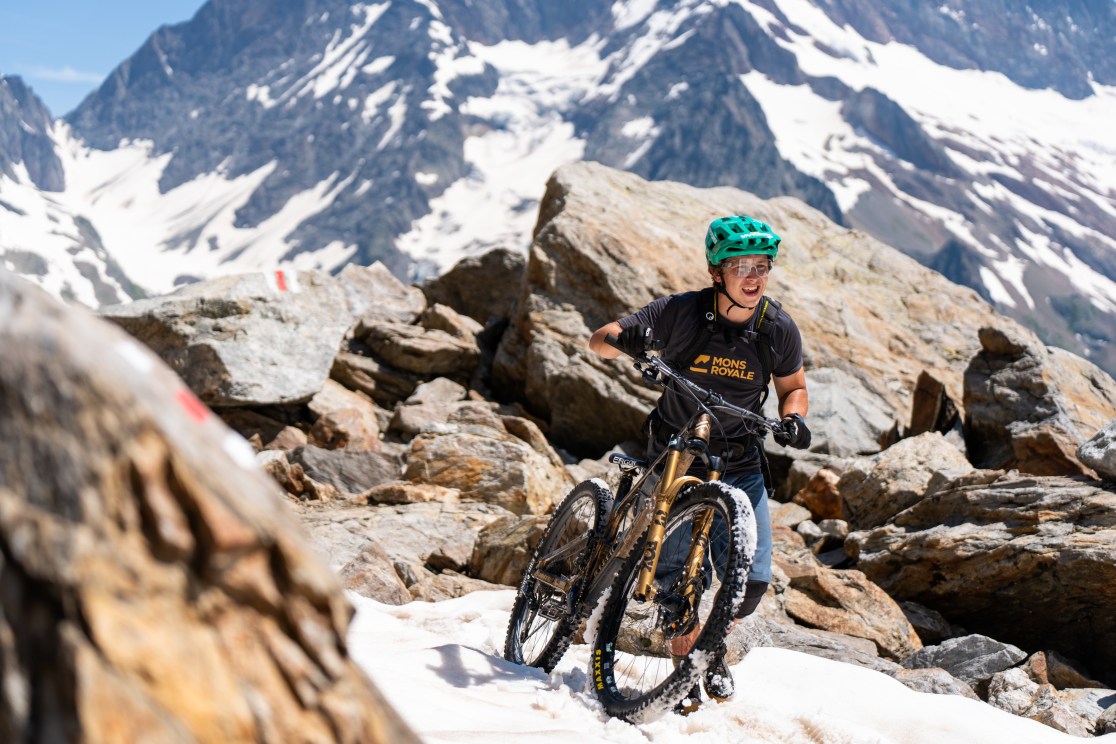
@matthewfmtb
matthewfairbrother.com
An enduro racer who’s not afraid to step out of their comfort zone, most known for his bikepacking adventures in between World Cup race antics.
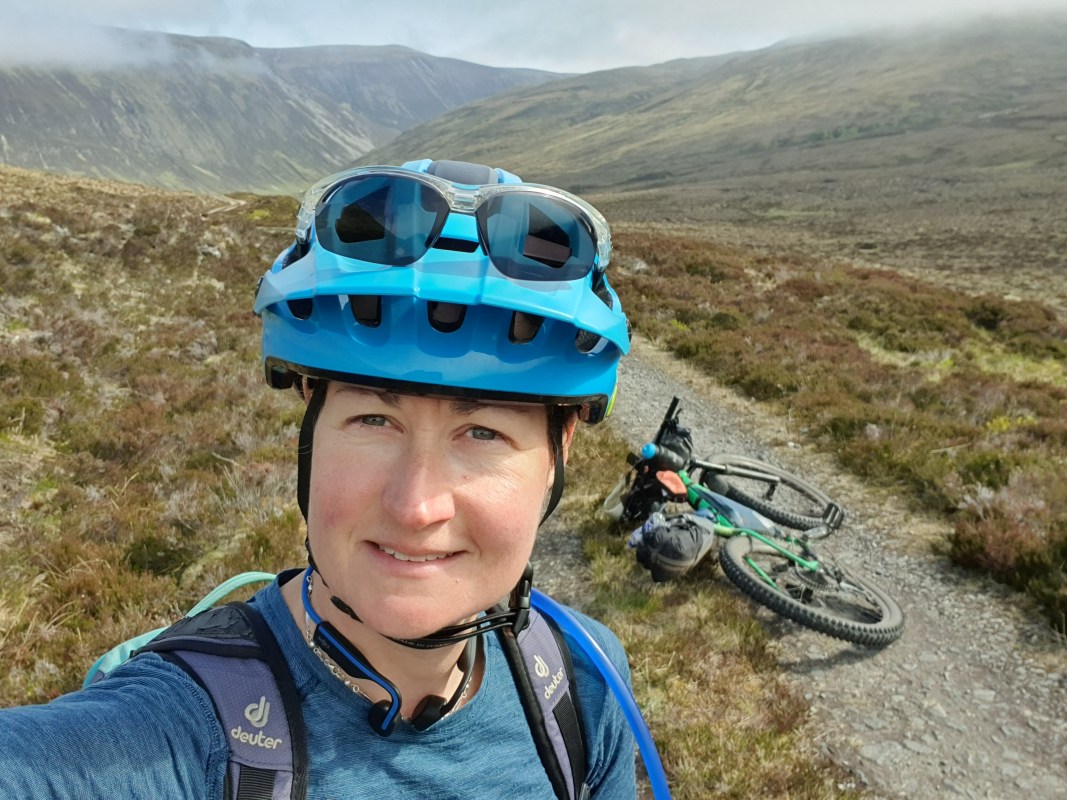
@recce_mtb_adventures
onarecce.com
Professional MTB Guide and enthusiastic ultra-distance MTB rider/adventurer
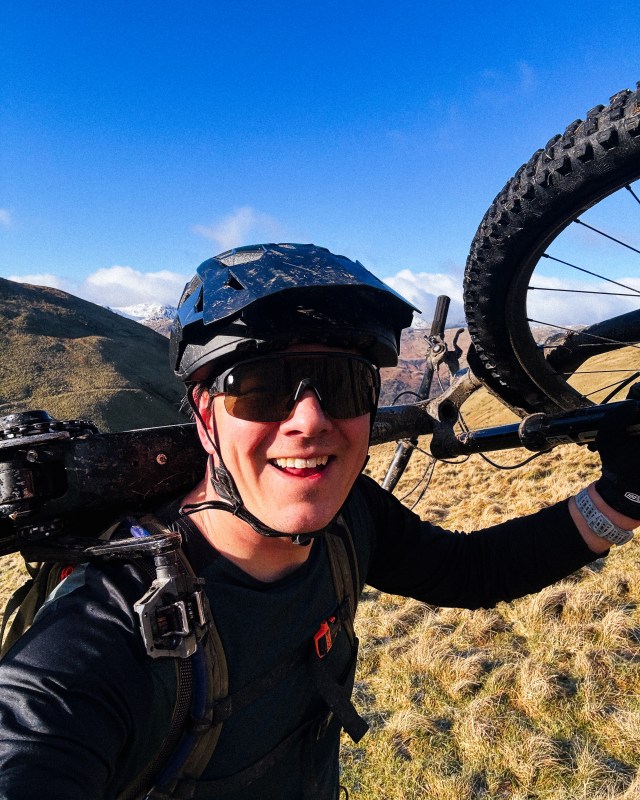
@jamesvincent
jamesianvincent.com
Photographer, Designer and Mountain biker
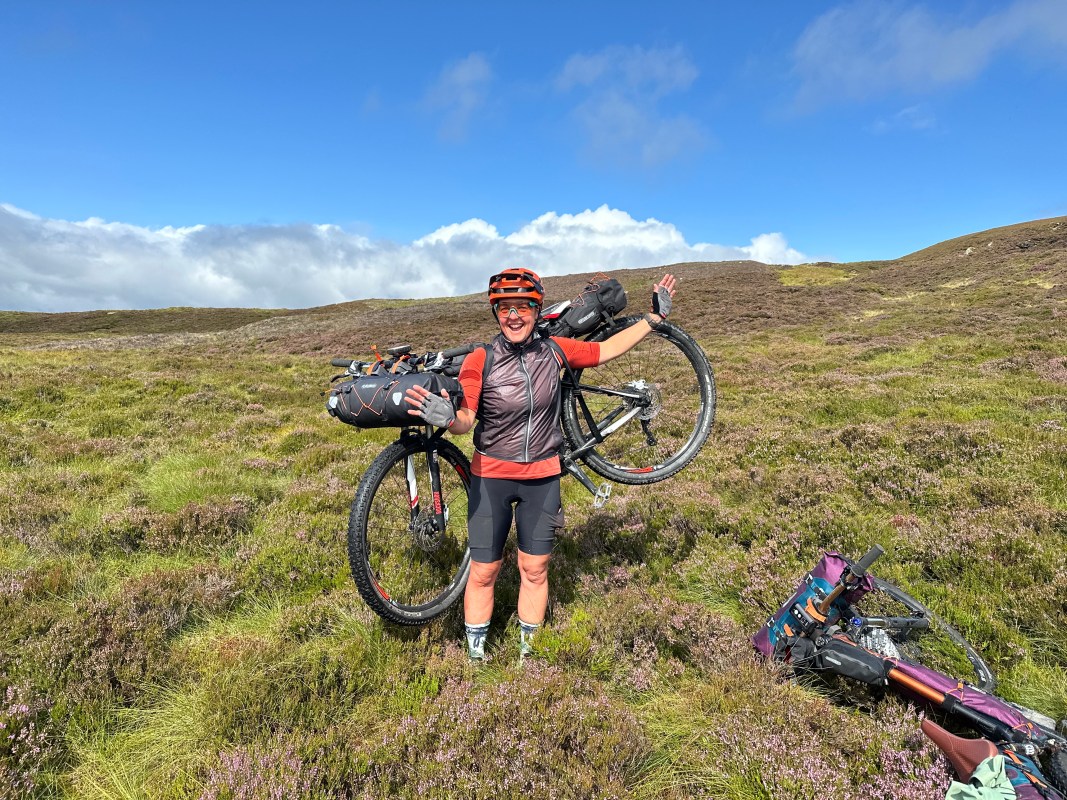
@emilyswildadventures
comriecroftbikes.co.uk
Professional guide, coach and a British Cycling leadership tutor.




